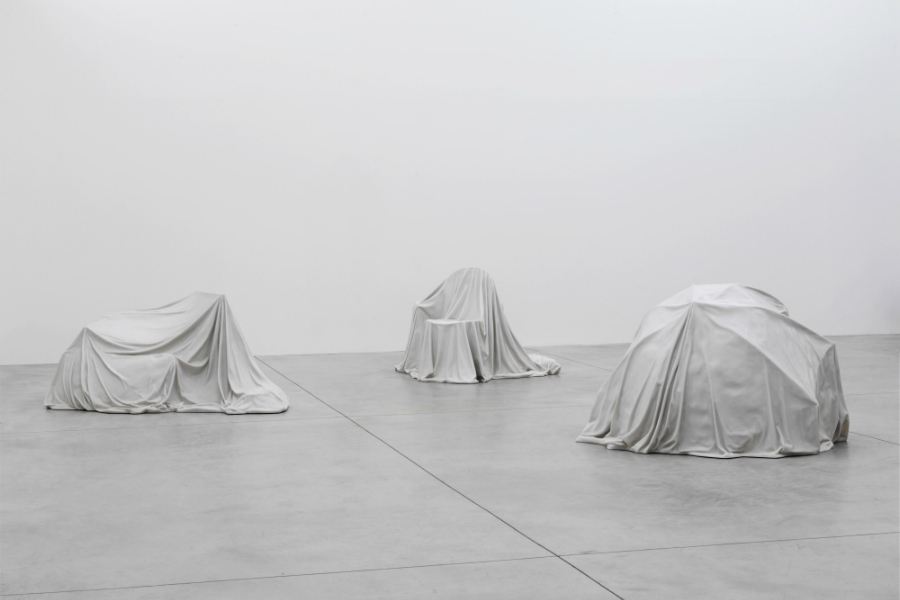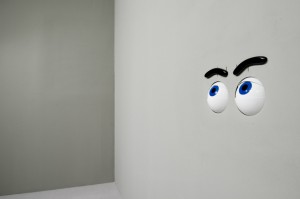Ryan Gander, Make Every Show Like It’s Your Last — Reviewed

By using sincere aspiration and tongue-in-cheek self-mockery, Ryan Gander shows us that imagination makes our lives better, says curator Eleanor Clayton…
Ryan Gander’s largest UK show to date, Make Every Show Like It’s Your Last, is currently at the Manchester Art Gallery on the second leg of an epic international tour. The title is a riff on a famous Steve Jobs quote — ‘Live each day as if it was your last’ — imbued with the humour of an artist who has made the show once before, and knows he will repeat the process a further three times before the tour is over. The mixture of sincere aspiration and tongue-in-cheek self-mockery turns out to be an apt starting point to the exhibition.
The first room features two of Gander’s Associative Ghost Templates (2012), wall-mounted perspex squares with geometric shapes cut out to create shadowy abstract patterns. They set the tone of the exhibition as a mystery to be solved, an intention explicitly outlined in the exhibition leaflet. The absences are numbered and described in white on a clear perspex label displayed alongside, causing the viewer to lean in and squint to make out sometimes baffling descriptions: ‘083 An A4 sheet of paper containing a hand written list of items numbered 83-118 used as material in an artwork taking the form of a performative lecture entitled LAX. The list begins with ‘Le Corbusier’ and ends with ‘Ripping me off’.’
By removing the assorted working materials, a degree of the creative process is hidden, and the messy faltering process blankly glossed over. The same could be said of nearby sculptures which resemble classical studies of draped marble, but which are in fact casts of dens made by the artist’s daughter; rough edges of various identifiable household objects smothered by a blanket which has been turned opaque, white and pristine. Both series of works give clues of the creative process to those who look closely. As outlines of a chair or pillow hint at the resourcefulness of a child on the hunt for den materials, so Associative Ghost Templates allude to Gander’s multifarious sources of inspiration.
Perhaps the point is not creativity hidden, but to prompt an imagining of what such a list – with the starting and end point given – might include, or what each form under the drapery could be. Large scale photographs of row upon row of blank cartoon boxes reinforce the thought that Gander is acting as provocateur, offering only partial information to illicit an infinite array of possible ideas in the visitor.
The second room is dominated by the sound of Magnus Opus (2013), a pair of mechanical cartoon eyes which follow you across the room, blinking loudly in case you might forget you are being watched. A film follows art students copying Francis Bacon paintings, intercut with interviews where Gander points out that the students as viewers have become subjects of this filmic portrait, which in turn is being studied by the ‘making of’ film we are watching. Gander asks: ‘What is a study? What is a portrait?’

Dominating this space as a possible answer is C++ (2013), tens of used perspex palettes hung across an entire wall salon-style, complete with an accompanying laminated numbered key. The key reveals the title for each: ‘Please be patient’, followed by a description of a person and setting, suggesting that the palettes are remnants of existing painted portraits – however implausible that might seem from the descriptions. The portrait given by the accumulation of palettes is of Gander himself, through his exchanges with friends, family, colleagues and strangers. A self-portrait through one’s interactions with the world, and all the while the cartoon eyes are watching.
The encouragement to act continues with a short film, commissioned by Gander as an advert for a faux government initiative, Imagineering (2013). Tonally it is perfect; the voiceover and style exactly in line with contemporary public service communications. The message hammers home much that is implied by previous works, that imagination makes our lives better, and should be encouraged in adults as much as in children.
Gander leads by example in the next gallery, a gaggle of Lamps (2013) made by the artist for his wife, cobbled together from colanders or foil serving trays which inspire persistently heroic yet achievable home-made creativity and DIY. At the far end of the gallery, Tank with Entrance to a Clearing (2013), eggs you on – an enticing path into a verdant woodland, a light breeze wavering the branches seductively. How far will you step into Gander’s world?
Interspersed throughout the show are works that look at the world of possibilities in ways that are both touching and personal (a photograph of the artist’s family before he was born), or funny and irreverent (a coin ‘from 2032’, travelled through time and stuck to the floor as a sci-fi take on a classic practical joke). Although often highly conceptual, the humour or pathos make the work engaging, and the experience of tracing or making connections – accurate or not seems hardly the point – is extremely enjoyable.
Gander’s smart aesthetic runs throughout, creating a satisfyingly balanced and neatly curated exhibition which underlines key ideas within an intriguing practice and almost functions as a multi-part work of art in itself.
Eleanor Clayton
Make Every Show Like It’s Your Last continues at Manchester Art Gallery until Sunday 14 September 2014 — free entry





